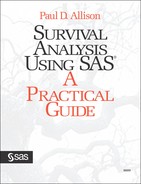Introduction
This chapter shows how to use the LOGISTIC, PROBIT and GENMOD procedures to analyze data in which many events occur at the same points in time. In Chapter 5, “Estimating Cox regression Models with PROC PHREG,” we looked at several different methods for handling tied data with PROC PHREG. There we saw that Breslow’s method—the standard formula for partial likelihood estimation with tied data—is often a poor approximation when there are many ties. This problem was remedied by two exact methods, one that assumed that ties result from imprecise measurement and another that assumed that events really occur at the same (discrete) time. Unfortunately, both of these methods are computationally demanding for large data sets with many ties. We also looked at tied data in Chapter 4, “Estimating Parametric Regression Models with PROC LIFEREG,” under the heading of interval censoring. While PROC LIFEREG is adept at estimating parametric models with interval censoring, it cannot incorporate time-dependent covariates.
The maximum likelihood methods described in this chapter do not suffer from these limitations. They do not rely on approximations; the computations are quite manageable even with large data sets; and they are particularly good at handling large numbers of time-dependent covariates. In addition, the methods make it easy to test hypotheses about the dependence of the hazard on time.
The basic idea is simple. Each individual’s survival history is broken down into a set of discrete time units that are treated as distinct observations. After pooling these observations, the next step is to estimate a binary regression model predicting whether an event did or did not occur in each time unit. Covariates are allowed to vary over time from one time unit to another.
This general approach has two versions, depending on the form of the binary regression model. By specifying a logit link, you get estimates of the discrete-time proportional odds model proposed by Cox. This method is directly analogous to the TIES=DISCRETE option in PROC PHREG. Alternatively, by specifying a complementary log-log link, you get estimates of an underlying proportional hazards model in continuous time. This is analogous to the TIES=EXACT option in PROC PHREG.
The mechanics of this approach are similar to those of the piecewise exponential model described in Chapter 4. The main difference is that the piecewise exponential model assumes that you know the exact time of the event within a given interval. By contrast, the procedures in this chapter presume that you know only that an event occurred within a given interval. That difference aside, the two approaches have the same advantages and disadvantages, and many of the same issues arise in implementation. For these reasons, anyone who wants to use the piecewise exponential model can benefit from reading this chapter.
